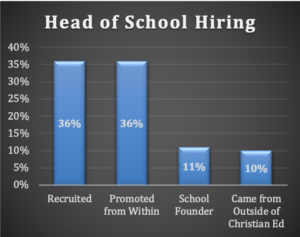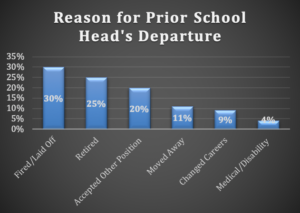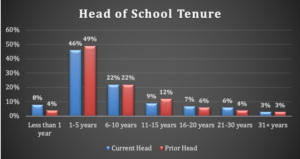In spring and summer 2019, the Association of Christian Schools International (ACSI) invited over 2500 member schools to participate in the annual ACSI Tuition and Salary Survey. The survey included a number of questions related to the profile of Christian school heads, including the areas of leader demographics, education and compensation, and hiring and tenure. This article shares related findings and discusses implications for each category.
Survey Background
A total of 746 member schools (705 in the U.S. and 41 international schools) responded to the survey invitation, representing a 29% response rate. Data was collected via an online survey platform from May 1 to July 18, 2019. Data analysis was conducted using SPSS, with the overall margin of error calculated at +/- 3.02%. Of the responding heads of school, 41% serve at an independent Christian school, while 59% work at church-affiliated schools. A third (33%) of school heads are employed at accredited schools. [Note that for both metrics, the survey sample is fairly representative of ACSI membership].
Leader Demographics
 Leader Age: The distribution of age ranges for current heads of school is skewed toward 50 years and above, with 60% of current school heads falling within this range. With 28% aged 60-69 and 32% aged 50-59, this suggests that nearly half of current Christian school leaders will be at or near traditional retirement age in the coming decade.
Leader Age: The distribution of age ranges for current heads of school is skewed toward 50 years and above, with 60% of current school heads falling within this range. With 28% aged 60-69 and 32% aged 50-59, this suggests that nearly half of current Christian school leaders will be at or near traditional retirement age in the coming decade.
 Gender: Of current heads of school, 56% are male, and 44% female. However, at the next layer of administration (e.g., principals, assistant heads, directors), this ratio is reversed; 57% of next-tier administrators are female, whereas 43% are male (at the 50% percentile).
Gender: Of current heads of school, 56% are male, and 44% female. However, at the next layer of administration (e.g., principals, assistant heads, directors), this ratio is reversed; 57% of next-tier administrators are female, whereas 43% are male (at the 50% percentile).
Race/Ethnicity: Although data on race and ethnicity among Christian school staff was not disaggregated by role, there is an overall lack of diversity among Christian school educators. At the 50th percentile, 3% of staff were African American, 5% Latino/Hispanic, and 82% Caucasian/White.
Discussion: One of the primary implications of the current study was a lack of diversity among Christian school educators. In the reporting Christian schools, the staff race/ethnicity profile tends to be heavily skewed toward Caucasians/Whites. Additionally, a narrower pathway for the transition of women from the secondary leadership level to the head of school level is another phenomenon evident the survey data: whereas 57% of second-tier school leaders are female, only 44% are male.
To address this, school leaders and boards should develop diversity-enhancing strategies within their schools that more closely mirror the body of Christ and their surrounding communities, not only to better reflect God’s Kingdom, but also to help ensure long-term sustainability with an increasingly diverse population. This will require closely examining explicit and implicit assumptions or biases that may be undermining recruitment and hiring of diverse candidates, as well as precluding high-quality leadership from having opportunities for advancement within a given school structure.
Finally, the fact that nearly one-third of heads of schools surveyed are nearing what is traditionally considered retirement age, with another third in such position within 10-15 years, suggests the strong need for leadership development and succession planning strategies. These strategies should target emerging leaders for professional development, mentoring, and networking opportunities, both inside the school community and in the broader sphere of Christian schools and private education. Current heads and boards also need to cultivate a vision for ministry and sense of calling that transcends their tenure at the school, so as to create appropriate mindsets to be active participants in the leadership development and succession planning processes.
Leader Education and Compensation
Education: In terms of the highest level of degree attained, the majority of school heads (63%) hold a master’s degree. Another 19% have earned a doctorate or professional degree. Thus, over 80% of school heads hold an advanced degree beyond the bachelor’s.
Compensation: The median head of school annual salary, across all school sizes, is $63,000. When examined by school size, however, school leader compensation rises along with enrollment. Specifically, median head of school compensation at schools based on school size is as follows:
- up to 100 students is $37,023;
- 101-200 students is $55,000;
- 201-400 students is $74,000;
- 401-700 students is $88,950; and
- 701 or more students is $146,065.
Discussion: One particularly poignant implication of this study is the under-compensation of the head of school in the Christian schools surveyed, relative to their counterparts in other types of schooling. According to the American Association of School Administrators, the average annual compensation for public school superintendents is $125,096, while the National Association of Independent Schools reports median head of school annual compensation in other independent schools as $225,000. For Christian school heads, the work is not any easier than in their public school or independent school counterparts. If anything, the work of a Christian head of school is more complex, given the pastoral/spiritual leadership responsibilities not required of other positions.
The relatively low compensation in private Christian schools is concerning for multiple reasons. First, it sets a normative ceiling of systemically low compensation across the organizations surveyed. Where the head of school is under-compensated, other administrators and teachers will most likely be under-compensated, as well. Second, given the previously mentioned advancing age of surveyed heads of schools, under-compensation will likely result in school boards having increasing difficulty in recruiting and securing qualified school heads for their positions. And third, under-compensation can also contribute to greater head of school turnover, which creates systemic cultural and consistency issues associated with a “rotating door” of school leadership. Indeed, there may be a connection between the relative under-compensation of heads surveyed and the relatively short tenure findings, discussed below.
Leader Hiring and Tenure
 Hiring: Current heads of school were recruited from other educational positions outside the school and promoted from within at the same rate (36%). Another 11% are the founders of their current school, and 10% came to their role from outside of Christian education (e.g., from church or other ministry, business or industry, etc.).
Hiring: Current heads of school were recruited from other educational positions outside the school and promoted from within at the same rate (36%). Another 11% are the founders of their current school, and 10% came to their role from outside of Christian education (e.g., from church or other ministry, business or industry, etc.).

In regard to the departure of the prior head of school, heads were most likely to have been fired or laid off (at 30%). An additional quarter of prior heads of school retired from the role.

Tenure: Nearly half of all heads of school (46%) have served at their current schools for five years or less, and the statistic for the preceding heads of school was similar (49%). The next largest category of heads are those who have served for 6-10 years at the school, at 22% for both current and prior heads of school.
Discussion: The survey data suggests relatively high turnover at the head of school position, with the majority of both current and prior school heads serving five years or less. By comparison, according to the National Association of Independent Schools, the average tenure of heads at other private schools is 12.6 years (with their predecessors at 13.1 years). This is a somewhat alarming comparison, when coupled with data suggesting that nearly a third of Christian school heads are fired from their positions.
Given the high financial, emotional, and organizational cost of replacing the head of school, as well as the challenges of securing strong replacement candidates as discussed earlier, school boards and their heads should determine clear metrics as to what constitutes success within the school context, and to agree to let those metrics govern school and leadership success. They should also engage intentionally in professional development regarding healthy conflict resolution.
With regard to hiring, 46% of all heads of school were hired from outside their respective organizations (either from other schools or industries), as opposed to 36% who were promoted within. This finding suggests a need for school leadership and governing bodies to engage in healthy leadership development practices within their schools, by raising up emerging leaders and compensating those leaders fairly so as to keep them in the school long enough to serve as the next generation of school leadership.
Conclusion
On the whole, the results of the survey would suggest that many schools are not yet engaging in best practices that contribute to long-term school sustainability—such as benchmarking salaries of teachers and administrators to local or other relevant standards with the goal of ensuring a high-quality, committed staff; and, engaging in the leadership development and school board training practices necessary to ensure strong healthy board/head relationships and leadership succession. Other findings of the survey (detailed in the larger report) suggest areas for improvement in school management, such as charging families what it costs to educate students according to high standards of academic quality. Thus, school leaders and boards are encouraged to use the survey data presented in the larger report, as well as in this article, to engage in rich and collaborative discussions centered around developing robust strategic planning in order to ensure healthy practices at their schools.
About the Authors
 Dr. Lynn Swaner is the Chief Strategy and Innovation Officer at ACSI, where she leads initiatives and develops strategies to address compelling questions and challenges facing Christian education. Prior to joining ACSI she served as a Christian school administrator and a graduate professor of education. Dr. Swaner serves as a Cardus Senior Fellow and is the lead editor of the books MindShift: Catalyzing Change in Christian Education and PIVOT: New Directions for Christian Education, co-author of Bring It to Life: Christian Education and the Transformative Power of Service-Learning, and editor of the ACSI blog. She received her EdD from Teachers College, Columbia University, in New York City. She can be reached via email at lynn_swaner@acsi.org.
Dr. Lynn Swaner is the Chief Strategy and Innovation Officer at ACSI, where she leads initiatives and develops strategies to address compelling questions and challenges facing Christian education. Prior to joining ACSI she served as a Christian school administrator and a graduate professor of education. Dr. Swaner serves as a Cardus Senior Fellow and is the lead editor of the books MindShift: Catalyzing Change in Christian Education and PIVOT: New Directions for Christian Education, co-author of Bring It to Life: Christian Education and the Transformative Power of Service-Learning, and editor of the ACSI blog. She received her EdD from Teachers College, Columbia University, in New York City. She can be reached via email at lynn_swaner@acsi.org.
 Jay Ferguson, JD, PhD,is the headmaster of Grace Community School, Tyler, Texas. He practiced law for 10 years and, in 2002, joined Grace as development director before assuming the headmaster role in 2003. He’s written extensively on Christian education and training children, including his weekly blog, JaysBlog. He can be reached via email at jferguson@gracetyler.org.
Jay Ferguson, JD, PhD,is the headmaster of Grace Community School, Tyler, Texas. He practiced law for 10 years and, in 2002, joined Grace as development director before assuming the headmaster role in 2003. He’s written extensively on Christian education and training children, including his weekly blog, JaysBlog. He can be reached via email at jferguson@gracetyler.org.

